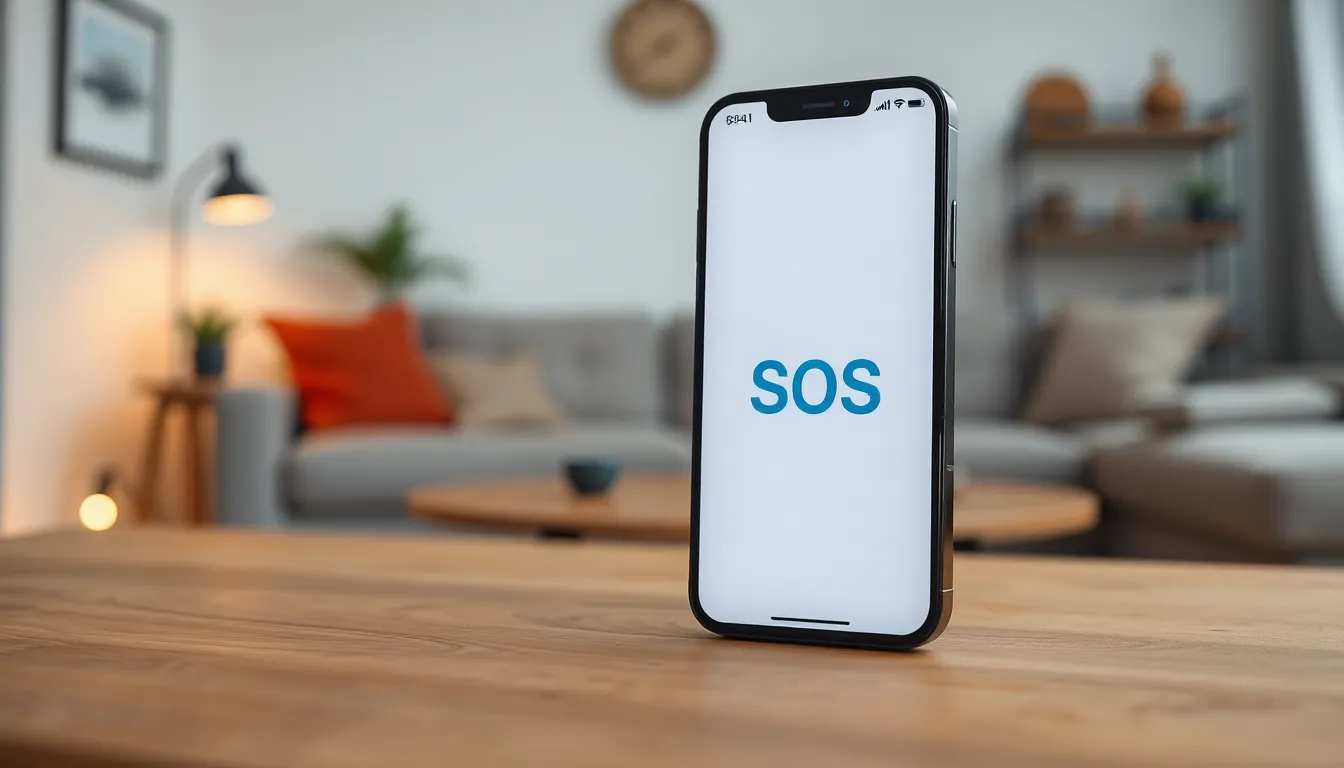Imagine you’re trying to call your best friend for a night out, but instead, your iPhone 13 decides to play the ultimate prank by displaying “SOS.” Panic sets in as you wonder if your phone’s auditioning for a role in a disaster movie. Fear not; fixing this pesky SOS issue is easier than finding a good Wi-Fi connection.
Table of Contents
ToggleUnderstanding SOS Functionality on iPhone 13
SOS functionality on the iPhone 13 provides an emergency feature for users. This function enables users to contact emergency services quickly in dire situations. It activates when a user presses and holds the side button along with the volume buttons. Moreover, the screen displays the option to call emergency services immediately.
It’s important to understand SOS mode. When enabled, the phone can automatically send alerts to emergency contacts. Location information is shared to ensure swift assistance. Users can set up emergency contacts through the Health app, making it easier to reach those who can help.
Receiving an SOS notification often indicates connectivity issues. If no cellular network is available, the device may display “SOS” instead of the signal strength. Some interruptions occur in areas with poor reception, causing the phone to rely on emergency calls only. It’s essential for users to check their network settings if this happens frequently.
Many iPhone 13 users may notice SOS mode appearing unexpectedly. In some cases, this can occur due to accidental button presses. Understanding device sensitivity can help prevent these incidents. Knowledge of how to disable SOS mode is crucial for maintaining normal phone functionality.
To deactivate SOS mode, users must navigate to settings. From there, they can manage emergency features to ensure functionality aligns with their preferences. Clarity in understanding how SOS operates empowers users to handle their devices effectively, especially in emergencies.
Common Causes of SOS Mode Activation

Multiple factors can trigger SOS mode on the iPhone 13. Understanding these causes helps users troubleshoot effectively.
Software Glitches
Software glitches often lead to unexpected SOS activation. Corrupted system files or outdated software versions can interfere with normal functionality. Frequent app crashes also contribute to this issue. Users typically notice SOS mode appearing after a software update or app download. Regularly updating the iPhone’s software is essential for minimizing glitches. Resetting network settings sometimes resolves connectivity-related SOS activations as well. Those who encounter persistent issues may consider restoring the device to factory settings, ensuring a fresh start.
Hardware Issues
Hardware issues can also cause the iPhone 13 to enter SOS mode. Faulty buttons on the device often trigger this mode accidentally. Physical damage, such as a cracked screen, may result in erratic behavior. Users should inspect their devices for indicators of impact or wear. Additionally, connectivity components such as antennas can malfunction, affecting signal strength. Poor reception in specific areas often exacerbates these hardware-related problems. Ensuring the device undergoes regular maintenance or repairs can prevent hardware-related SOS incidents.
How to Fix SOS on iPhone 13
Resolving the SOS issue on an iPhone 13 requires a few straightforward steps. Following each step can help ensure proper device functionality.
Restarting Your iPhone
Restarting the iPhone often resolves minor glitches. To do this, press and hold the side button along with either volume button until the slider appears. Slide to power off the device. Wait for 30 seconds before turning it back on by holding the side button until the Apple logo appears. This simple action can eliminate temporary software issues that may cause SOS mode activation.
Checking Cellular Settings
Cellular settings play a crucial role in connectivity. Go to Settings and tap Cellular to ensure that cellular data is enabled. Verify the option for Enable LTE is activated, which can enhance signal strength. Additionally, check if Airplane Mode is off, as this mode disables all network connections. Adjusting these settings can often resolve recurring SOS notifications.
Updating iOS Software
Keeping the iOS updated is essential for optimal performance. Navigate to Settings, then tap General, and select Software Update. If an update is available, download and install it. Updates routinely include bug fixes that may eliminate SOS mode occurrences caused by software errors. Regularly updating the device ensures its features function correctly.
Resetting Network Settings
Resetting network settings can address persistent SOS situations due to connectivity issues. Open Settings, tap General, and select Reset. Choose Reset Network Settings to restore default configurations. This action clears saved Wi-Fi networks and passwords but often resolves network-related problems that trigger SOS mode. Ensure proper setup of network connections afterward to maintain reliable service.
Alternative Solutions
Several options exist for addressing the SOS issue on the iPhone 13. Users can explore various methods to restore normal functionality.
Contacting Your Carrier
Contacting the carrier often helps resolve connectivity issues that trigger SOS mode. They can check if there are network outages in the area or problems with the user’s account. Explaining the situation succinctly aids customer service representatives in providing effective support. They may suggest resetting the SIM card or even re-activating the device on their network. If problems persist, the carrier can guide users through additional troubleshooting steps specific to the carrier’s network settings.
Visiting an Apple Store
Visiting an Apple Store offers hands-on assistance for persistent SOS issues on the iPhone 13. Apple’s technicians can diagnose hardware-related problems that users might miss. During a visit, individuals can request a comprehensive device check, which often reveals any underlying issues. The technicians can also provide updates on relevant software changes or perform repairs when necessary. Scheduling an appointment online minimizes wait time and ensures access to expert help when needed.
Dealing with the SOS feature on an iPhone 13 can be frustrating but it doesn’t have to be. By understanding the causes and taking the right steps users can easily resolve the issue. Whether it’s a minor glitch or a connectivity problem knowing how to troubleshoot effectively can save time and stress.
Regular maintenance like updating software and checking network settings can prevent unexpected SOS activations. For persistent issues reaching out to the carrier or visiting an Apple Store can provide the necessary support. With these strategies in hand users can ensure their iPhone remains reliable and ready for any situation.






